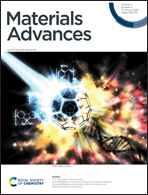Evaluation of techniques used for visualisation of hydrogel morphology and determination of pore size distributions†
Abstract
This study evaluated three techniques, stimulated emission depletion (STED) microscopy, atomic force microscopy (AFM), and cryogenic scanning electron microscopy (Cryo-SEM), for visualising the morphology and obtaining pore size information of agarose hydrogels (0.38, 1.0, 1.5, 2.0% agarose content). The pore size distributions were obtained using a common manual approach which was validated for Cryo-SEM data using poly(lactic-co-glycolic acid) (PLGA) nanoparticles as an internal standard. There was good agreement in pore size distribution data for agarose hydrogels with an agarose content of 1.0% and higher when using these techniques. For the 1.0% gel sample imaged using STED and Cryo-SEM, no significant difference was observed between these two techniques yielding average pore sizes of 240 and 230 nm, respectively. The average pore size values obtained from AFM images for 1.5 and 2.0% gel samples were significantly smaller by 10–15% compared to values obtained from Cryo-SEM data as predicted due to the AFM tip artefact for concave features. Pros and cons of each technique are discussed in detail.



 Please wait while we load your content...
Please wait while we load your content...